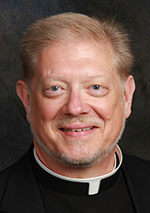That All May Be One / Fr. Rick Ginther
‘From conflict to communion’ must be at heart of dialogue
 Well, I was glued to my laptop on Monday morning and into the afternoon on Oct. 31. Why?
Well, I was glued to my laptop on Monday morning and into the afternoon on Oct. 31. Why?
As I noted at the conclusion of last month’s column, the Lutheran World Federation (LWF), the Catholic Church, and other international Christian leaders, gathered for prayer together in Lund and Malmö, Sweden. These moments of prayer opened the yearlong commemoration of the 500th anniversary of the start of the Reformation.
Pope Francis was present and spoke at both events.
The prayer form used at the Lutheran Cathedral of Lund was one jointly produced by the LWF and the Pontifical Council for Promoting Christian Unity.
This same prayer form will be used at the Week of Christian Unity celebration in Indianapolis on Jan. 18, 2017. The location is yet to be determined, and will be announced in my December column.
At both Lund and Malmö, I repeatedly heard the words “from conflict to communion.” It was more than a catchy phrase. It is the title of the foundational work which describes the present historic movement toward unity, and calls for such prayerful commemorations.
“From Conflict to Communion: Lutheran-Catholic Common Commemoration of the Reformation in 2017” is a report of the Lutheran-Roman Catholic Commission on Unity.
In its first chapter, the authors reflect on the character of previous commemorations (anger, condemnation, continuing to promote division rather than unity).
They then state, that in this new ecumenical age, the character must change. They propose that any commemoration in this new age must reflect four elements: thanksgiving, repentance, common witness and commitment.
Chapter two outlines new perspectives on Martin Luther and the Reformation. It notes the deeper research on the Middle Ages, and 20th-century Catholic research on Martin Luther. It points to the many dialogue sessions and ecumenical projects which have resulted in a richer, more complete picture of the historical moment and realities at the time of the Reformation.
Chapter three provides an historical sketch of the Lutheran Reformation and the Catholic response (Counter-reformation).
Chapter four outlines basic themes of Martin Luther’s theology “in light of the Lutheran-Roman Catholic Dialogues.” This section is most important to understand the benefits of dialogue, and how it moves folks to common understanding—and then toward unity.
Chapter five states that baptism is the basis for unity and common commemoration. There follows a call for preparations. Those involved are to note their shared joy in the Gospel, reasons for regret and lament, evaluation of the past, and confession of sins against unity by both Catholics and Lutherans.
Chapter six is profound. It outlines five ecumenical imperatives. They are:
-
“Catholics and Lutherans should always begin from the perspective of unity and not from the point of view of division in order to strengthen what is held in common even though the differences are more easily seen and experienced.”
-
“Lutherans and Catholics must let themselves continuously be transformed by the encounter with the other and by the mutual witness of faith.”
-
“Catholics and Lutherans should again commit themselves to seek visible unity, to elaborate together what this means in concrete steps, and to strive repeatedly toward this goal.”
-
“Lutherans and Catholics should jointly rediscover the power of the Gospel of Jesus Christ for our time.”
-
“Catholics and Lutherans should witness together to the mercy of God in proclamation and service to the world.”
The full text of the report can be found at goo.gl/24y0x. It is an enlightening read.
(Father Rick Ginther is director of the archdiocesan Office of Ecumenism. He is also pastor of Our Lady of Lourdes Parish in Indianapolis.) †
 Well, I was glued to my laptop on Monday morning and into the afternoon on Oct. 31. Why?
Well, I was glued to my laptop on Monday morning and into the afternoon on Oct. 31. Why?